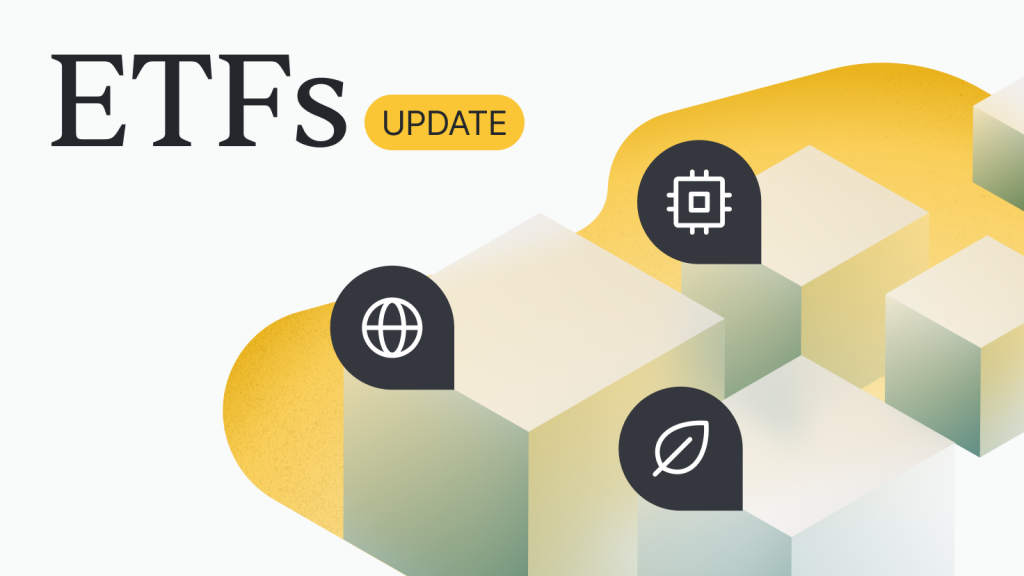In this guide, we’ll provide you with a clear and concise understanding of Exchange-Traded Funds (ETFs) and how Mintos offers a practical approach to investment. Whether you’re new to ETFs or a seasoned investor, our goal is to equip you with the knowledge and tools you need to make informed investment decisions.
Understanding ETFs
An exchange-traded fund, also known as an ETF, is a type of investment fund that you can trade on a stock exchange. ETFs offer an easy way to invest in a diversified portfolio of assets, such as stocks, bonds, or commodities.
Let’s say you want to invest in technology companies like Apple, Microsoft, and Google. Instead of buying each company’s stock separately, you can invest in a technology ETF. This approach is simpler and offers more diversified investment options, as a technology ETF already includes these, and many more tech-related stocks. By pooling various tech stocks into one fund, it streamlines the investment process, making it more cost-effective to maintain a diversified portfolio.
ETFs have seen remarkable growth in the investment landscape in recent years. According to research conducted by iShares, ETFs now represent a substantial portion of equity assets, accounting for 12.7% in the U.S., 8.5% in Europe, and 4.4% in Asia-Pacific. This data highlights the increasing importance of ETFs in the global investment arena.1
ETFs work by tracking the performance of a specific index, commodity, bond, or group of assets. However, what sets them apart is that ETFs are traded on stock exchanges like regular stocks throughout the trading day.
The key benefit of ETFs lies not only in their ability to provide investors with diversified exposure to a wide range of assets, but also in their cost-effectiveness and enhanced liquidity.
Unlike actively managed funds, ETFs typically track an index (passive management), which results in lower management fees. These lower expenses directly translate into higher returns for investors.
Regardless of where you buy your ETFs, they are subject to a Total Expense Ratio (TER). The TER is charged by the ETF provider (such as Vanguard or Blackrock), which typically is a financial institution or investment company that creates and manages the fund. This standard charge encompasses the costs associated with running the ETF, such as management fees, administrative expenses, and various operational charges.
This fee is taken out of the ETF’s total assets, impacting the total returns you receive from your investment. The TER is a fundamental aspect of ETF investment and is consistently applied across all trading platforms and markets.
Additionally, many ETFs offer the advantage of accumulating, with automatic dividend reinvestment. This feature allows investors to efficiently increase their holdings without incurring extra transaction fees, further augmenting the cost-effectiveness of ETF investments.
The combination of these factors — diversification, lower costs, liquidity, and dividend reinvestment — makes ETFs a compelling choice for a broad spectrum of investors.
Advantages and disadvantages of ETFs
ETFs offer a range of advantages and disadvantages that can significantly impact an investor’s portfolio. In this discussion, we will explore the key benefits and drawbacks of ETFs, shedding light on why they have gained such prominence in the world of finance.
Advantages
- Diversification: ETFs typically hold a diversified portfolio of assets, such as stocks, bonds, commodities, or other financial instruments. This diversification helps to spread risk across various assets. Additionally, ETFs provide diverse investment options, covering a spectrum of asset classes and strategies. This allows investors to tailor their investments to specific sectors, regions, or themes.
- Low TERs: ETFs often have lower TERs compared to actively managed funds, making them cost-effective investment options.
Suppose you invest €10 000 in an ETF with a 0.1% TER and another €10 000 in a mutual fund with a 1% TER. Over the course of a year, the ETF would cost you €10 in fees, whereas the mutual fund would cost you €100. By choosing the ETF, you could save €90 in fees annually, which add up over time.
- Liquidity: ETF shares can be bought and sold on stock exchanges at market prices throughout the trading day. This provides investors with flexibility and liquidity.
- Transparency: ETFs disclose their holdings regularly, allowing investors to see the assets they own within the fund. This transparency helps investors make informed decisions.
- Tax efficiency: ETFs are structured in a way that could result in tax efficiency, potentially reducing the tax burden on investors.
- Alignment with market performance: ETFs present a cost-effective, passive management approach for investors looking to align with market or sector performance. By passively tracking indexes, ETFs eliminate the complexities and costs associated with active management. This strategy ensures that investors can participate in market trends without engaging in stock picking or market-timing.
Disadvantages:
- Brokerage commissions: while ETFs boast low expense ratios, the brokerage commissions incurred during buying and selling can add to the overall investment cost, contrasting with mutual funds which may have no such fees but higher expense ratios. Similarly, direct investments like individual stocks involve different fee structures, including potential brokerage commissions, without expense ratios, making brokerage commissions a notable consideration for both ETF and stock investors.
- Tracking error: some ETFs may not perfectly track their underlying index due to factors like management fees and trading costs, potentially leading to a tracking error.
An ETF is designed to follow a specific index, like the S&P 500. However, due to factors such as management fees and trading costs, the ETF’s performance may not perfectly match the index’s performance. For instance, if the index goes up by 10%, the ETF might go up by 9.8%. This slight difference is the tracking error.
- Limited active management: most ETFs passively track an index, limiting the ability for active management and stock selection.
- Potential premium or discount: ETFs can trade at a premium or discount to their net asset value (NAV), which may result from market sentiment or liquidity issues. Typically, ETFs trade very close to their NAV, but there can be differences, especially during times of high market volatility or low liquidity. Unlike mutual funds, which are traded once per day at their NAV, ETFs trade on stock exchanges at market prices throughout the trading day. These market prices can fluctuate based on supply and demand dynamics.
- Dividend taxation: dividend taxation is the taxation of income received by investors from their investments. While ETFs can be tax-efficient, investors may still face tax consequences on dividends, depending on their tax jurisdiction.
- Bid-ask spread: the bid-ask spread, which represents the difference between the buying (bid) and selling (ask) prices of an ETF, can impact trading costs, especially for less liquid ETFs. While ETFs are generally known for their liquidity, less liquid ETFs may have wider bid-ask spreads, potentially resulting in higher trading costs for investors in those specific ETFs.
Types of ETFs
The presence of diverse ETFs stems from the unique needs and objectives of investors. With varying financial goals, risk tolerances, and investment horizons, ETFs are designed to cater to these individual preferences, providing a versatile tool set for building well-rounded portfolios.
Name of ETF
Characteristics
Equity ETFs
Equity ETFs predominantly allocate their assets to stocks, making them a suitable choice for investors who wish to gain exposure to comprehensive market indices, particular sectors, industries, or countries.
These funds provide the opportunity for the growth of capital and may also distribute dividends, contingent upon the underlying assets within the ETF.
Fixed-income ETFs (also known as bond ETFs)
Fixed-income ETFs focus on bonds, providing investors with regular interest payments and capital preservation. These funds provide an avenue for diversification within the realm of fixed income assets, encompassing various types of bonds such as government bonds, corporate bonds, and municipal bonds.
Commodity ETFs
Commodity ETFs track the performance of physical commodities like gold, oil, or agricultural products. They offer exposure to tangible assets and can act as a hedge against inflation, making them attractive during economic uncertainties.
Currency ETFs
Currency ETFs concentrate on foreign exchange markets, enabling investors to speculate on or hedge against currency movements. These ETFs typically involve currency pairs and provide a way to trade currencies without opening a traditional forex account.
Multi-asset ETFs
Multi-asset ETFs hold a mix of different asset classes, such as stocks, bonds, and commodities. They aim to provide a diversified, all-in-one solution for investors with varying risk profiles, simplifying portfolio construction.
Alternative ETFs
Alternative ETFs invest in non-traditional assets like hedge funds or private equity. They offer diversification benefits and low correlation to conventional investments, potentially reducing overall portfolio risk.
Sustainable ETFs
Sustainable ETFs focus on companies with strong ESG (Environmental, Social, Governance) practices. They are a subset of equity ETFs, but the selection criteria focus on companies that meet ESG standards. Investors and institutions are aligning their financial strategies with environmental, social, and governance principles, mirroring a larger societal pivot towards sustainability and ethical conduct. These ETFs allow investors to align their portfolios with their personal values.
How to buy ETFs
Commonly, ETFs are purchased through a broker, which serves as an intermediary between investors and ETFs. A brokerage account is your gateway to ETF investments, and you have the choice of selecting from online brokerage platforms or opting for a more traditional, in-person brokerage service. To make the most of your ETF investments, consider the following:
- Investment objectives: determine your investment goals—whether it’s long-term growth, generating income, or following a specific strategy.
- Portfolio diversification: choose ETFs that align with your investment strategy and help spread risk effectively across your portfolio.
- Market research: continuously monitor and research market developments that could impact your ETF investments.
- Regular portfolio review: periodically assess your portfolio’s performance and make adjustments as needed to stay on track with your goals.
- Broker selection: carefully choose your broker, considering factors like fees, available ETFs, and the quality of service and tools they offer.
With Mintos Core ETF, we cut out the groundwork for our investors. We understand that navigating the world of ETFs can be daunting, with thousands of options to choose from. That’s why we’ve taken the initiative to simplify your investment journey and offer you a seamless way to build your portfolio.
Mintos Core ETF is designed to eliminate the complexities of ETF selection. With Mintos Core ETF, you’re not just getting convenience; you’re gaining access to a thoughtfully crafted portfolio of low-fee ETFs spanning various asset classes and regions. Our commitment to dynamic rebalancing ensures your portfolio stays on track with your long-term objectives, all while minimizing tax implications.
Investments start from just €50, with zero commissions. Enjoy the freedom to invest or sell anytime, without any hidden fees.
1 This information was accessed as of December 2023, and it may not reflect the most recent updates or numbers. We advise verifying the latest data before making any decisions or drawing conclusions.

